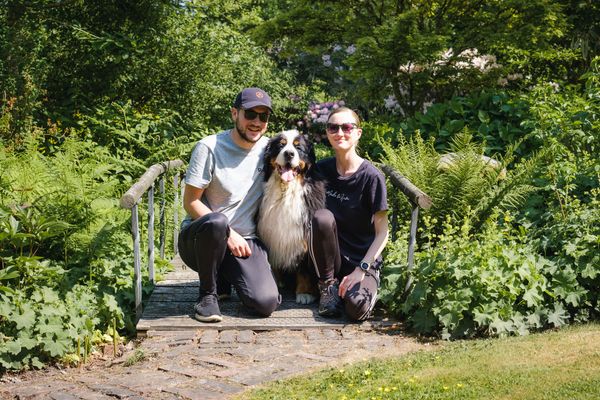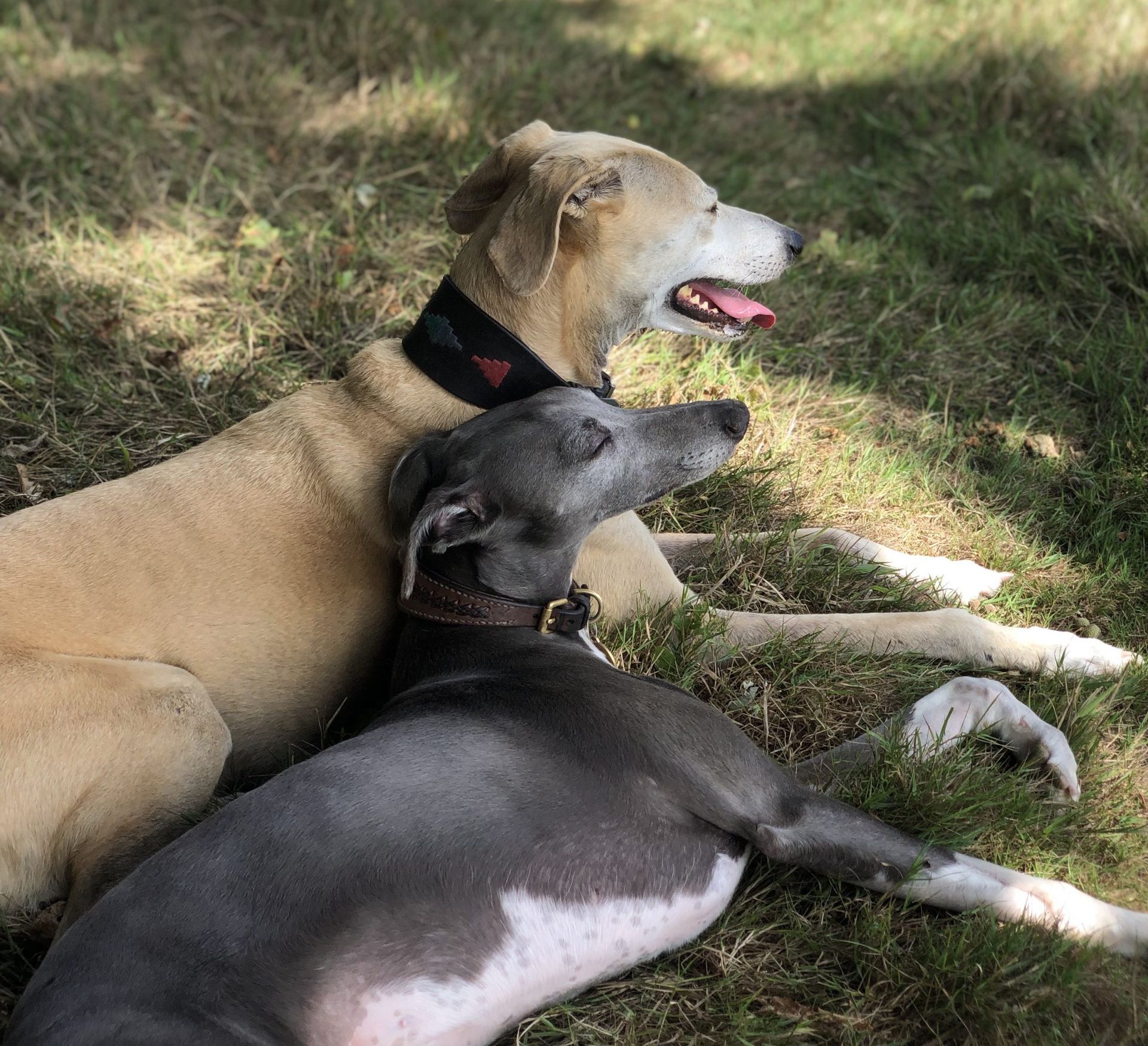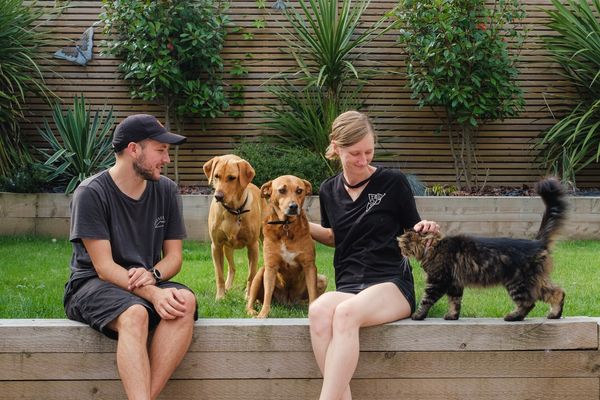We love the arrival of warm Summer days bringing the opportunity to spend more time outside. But if you’re a dog owner, or full time pet sitters like us, it’s important to take precautions on hot days to avoid dogs falling sick with heatstroke. It’s our job as pet sitters to look out for pooches’ best interests while they’re in our care, and this is no more vital than during our Summer bookings. We always take extra steps to ensure the safety of our four-legged friends in potentially dangerous weather, as cases of heatstroke can become severe if not treated quickly. Here we’ll take you through the symptoms to look out for in a dog, as well as ways to prevent heatstroke developing in the first place.
Table of Contents
What is heatstroke in dogs?
Heatstroke occurs in dogs as they are unable to cool down by sweating, like humans do, and as a result are less able to regulate their body temperature. Their bodies can’t cope with a sudden internal rise in temperature, and a dog will pant or seek out shade as a way of cooling down. This behaviour is normal but should be monitored for changes on hot days, especially if their panting becomes more frantic.
Dogs are particularly at risk to heatstroke as they love to run around! Almost 75% of heatstroke cases develop while dogs are playing or exercising. You may find you have to enforce some indoor time if your dog is prone to zoomies in the garden no matter the temperature. At one July house sit in Kent, Labrador Boris and Golden Retriever Olive loved to lay out in the big, open garden no matter how unbearably hot it was outdoors! We took the precaution to bring her inside to lay on the cool, tiled kitchen floor when the sun was beating down outside. It should be noted, though, that heatstroke can occur at any time – for example if a dog is simply sitting in an environment that is too warm, such as a car or conservatory without adequate air flow.
Any dog can develop symptoms of heatstroke, but some are more at risk, including:
- Flat-faced breeds such as Pugs, Bulldogs, Shih Tzus and Boston Terriers. Shockingly, British Bulldogs are 14 times more likely to develop heatstroke than Labradors, and Pugs are 6 times more likely! Dogs emit a significant amount of body heat from exhaling through their noses, and as these breeds have less space inside their nostrils, they are not as adept at expelling the heat from their bodies through panting alone
- Giant breeds such as Great Danes, St. Bernards, Mastiffs and Irish Wolfhounds. Their sheer size can make it difficult for them to cool down quickly
- Long-haired breeds such as Collies, Bernese Mountain Dogs and Chow Chows. All that extra fluff adds a thick layer of insulation that means these dogs struggle to expel the heat from their bodies – for example they won’t feel the benefit of lying on a cool floor as easily as a short-haired breed
- Overweight dogs or those with medical conditions that affect their movement
- Elderly dogs who, again, may have restricted movement
Ways to prevent heatstroke
As with any condition that can seriously affect your dog’s health and wellbeing, prevention is always better than a cure. Here are some simple ways to avoid heatstroke symptoms developing in the first place:
Get out early in the morning / late in the evening for walkies. Depending on the intensity of the weather and temperature, it may be safer to not walk your dog at all if it’s looking uncomfortably warm for them. If you do go out for a walk, let your dog set the pace and stay alert for any warning signs that they’re becoming tired or overheating. At a dog sit in Dartmoor, caring for Bernese Mountain Dog Floki, his thick fur meant he was in danger of overheating quickly and we spent our week in June together going for gentle, late evening strolls around the large, shaded garden. If you’re walking along roads or pavements, check the temperature of the ground with your hand – if you can’t leave your hand on the ground for up to five seconds, it’s too hot. Always remember to carry water for your dog and take rests if needed. You may have to rise a little earlier than usual to beat the heat, or wait until after dark when it’s cool again.
If you can’t get out for a walk when it’s cool, don’t risk it! If you have any doubts at all while pet sitting, contact the dog’s owner – they may advise you to shorten the length of your walk or avoid the risk and skip it altogether. There’s no need for unnecessary travel on a hot day, especially if you have to drive somewhere in a car to walk your dog. If you’re looking for ideas on how to entertain dogs at home, check out our dedicated blog post on keeping dogs entertained indoors.
Give dogs access to plenty of water. You might consider putting down extra water bowls at home during hot weather, so your pooch doesn’t forget to hydrate! It may also be a good idea to add ice cubes to the water to keep it cool – just make sure the cubes are an appropriate size for your dog so they don’t pose a choking hazard as you dog takes a drink. If a dog in our care has access to a garden or outdoor space, we like to put down these silicone water bowls instead of risking the owners’ indoor ceramic bowls getting broken. If these soft bowls get knocked over, they won’t break and double up as a good water bowl to take out on walkies.
Encourage dogs to get wet! At a handful of pet sits we’ve completed, the owners have provided an outdoor paddling pool for their dogs to enjoy cooling off while having fun too. At a pet sit in the Cotswolds, there was a stream just a short walk from the house where we could take Labradors Tala and Pepper to splash around. It’s always entertaining watching dogs playing together in pools and streams, knowing they’re safe from overheating. Just make sure you’re not forcing them to do unnecessary exercise – sometimes dogs don’t know when to stop, especially if there’s a tennis ball involved!
Provide shade indoors and outdoors. If your dogs are desperate to go out in the garden, make sure they have access to shaded areas so they’re able to relax out of direct sunlight. It’s important to provide shady spots in your home too – at previous Summer house sits we’ve spent time creating makeshift dens from dogs’ towels and bedding, draping them over chairs to provide a cool space for dogs to lay out of the heat and come and go as they please. Make sure they can easily get in and out of any shaded spots, and ensure there’s enough airflow going through the den so you don’t accidentally create a space that traps the heat in.
Make some cooling frozen treats! As a pet sitter, you should always check with a dog’s owner before giving their pets a new food. There are lots of dog-safe foods that can be frozen to provide dogs with a treat that cools them down, and in the past we’ve frozen carrots and apples for a crunchy, icy treat for dogs. Back in 2018, we house sat Duck Tolling Retriever Baloo who would excitedly gobble up frozen peas as a chilled treat! As with any hard treat, keep an eye on your dog while they’re eating them and be sure to remove any seeds or pips before giving fruit and vegetables to your pup.
Consider having their fur clipped. Not necessarily a tip for pet sitters unless you can sign it off with the dog’s owner, but if the weather starts to turn hotter it might be a good reason to have your dog’s fur trimmed. This will help them keep cool by removing a thick layer of insulating fluff, and you may find your dog is more comfortable when moving around on hot days.
Symptoms of heatstroke
The signs of heatstroke in dogs range drastically depending on the severity. Here’s a brief rundown of what look out for:
Mild symptoms:
- Excessive panting
- Fast breathing or difficulty breathing
- Lethargy or low energy
Moderate symptoms:
- Excessive drooling
- Foaming at the mouth
- Vomiting
- Diarrhoea
- Bright red gums or very pale gums
- Shaking that isn’t normal for your dog
- Weakness and collapse
Severe symptoms:
- Confusion
- Seizures
- Unconsciousness
- Vomiting with blood
- Diarrhoea with blood
If symptoms are moderate to severe take your dog to a vet immediately. See below for at-home treatment for mild symptoms.
Treatment
The treatment for heatstroke also varies depending on the severity of the symptoms. Most of the time, with mild symptoms, you can treat your dog with first aid at home by making simple adjustments. If you suspect your dog is developing heatstroke symptoms, here’s a few things to try:
Gently move your dog to a shaded area. Stop any form of exercise i.e. If your dog is running around or chasing a toy, and encourage them to sit calmly in a cool place. If your dog is outside in a garden, bring them indoors.
Create a through breeze. If you have one, you might consider placing a standing fan in the space to circulate the air in the room. During Summer we always travel with this handy USB fan that fits easily into a bag. Open windows to release any warm air that’s trapped in the room and make sure your dog isn’t laying in direct sunlight.
Offer your dog cold water. It may be that your dog has got a little overexcited and exerted themselves – make sure they know where fresh water is and gently encourage them to take a drink if you can. Don’t force your dog to drink water as this could cause further stress.
Slowly put cool water over your dog. Never use freezing cold water as this may shock them and, again, cause unnecessary stress. Wet a towel under the tap and gently rub their coat, or use a misting bottle to gently distribute the water over their body, leaving your dog’s face and especially their nose to avoid any distress while they’re panting. Never put a wet towel over your dog as this can make them hotter.
If these actions don’t help, take your dog to the vets to get them checked over as quickly as possible. The sooner you act, the better their chances of a smooth recovery.

We are Chris+Suze
Latest Posts

Book us as your petsitters
We offer a friendly, organised service to ensure your pets are happy and loved in your home while you’re away.
Find out more
Foldable dog bowl
We always carry a silicone bowl on our dog walks. Small enough to fold and fit in a bag, and has a carabiner to clip onto a belt loop.

Rechargeable USB Fan
This small but mighty fan is super handy for travelling! It comes with a cable to recharge the batteries so you don’t have to keep buying new ones, it has a sturdy base to stand on tables as well as a clamp to attach the fan at any angle, and the speed is fully adjustable!






